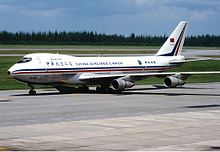

You can help expand this article with text translated from the corresponding article in Chinese. (October 2012) Click [show] for important translation instructions. Content in this edit is translated from the existing Chinese Wikipedia article at [[:zh:中華航空334號班機劫機事件]]; see its history for attribution.{{Translated|zh|中華航空334號班機劫機事件}} to the talk page. |

B-198, the aircraft involved, at Changi Airport a year before the incident.
| |
| Hijacking | |
|---|---|
| Date | May 3, 1986 (1986-05-03) |
| Summary | Hijacking |
| Site | Guangzhou Baiyun Airport, Guangdong, China |
| Aircraft | |
| Aircraft type | Boeing 747-2R7F/SCD |
| Operator | China Airlines |
| Registration | B-198 |
| Flight origin | Singapore Changi Airport |
| 1st stopover | Don Mueang Airport, Bangkok, Thailand |
| 2nd stopover | Kai Tak Airport, British Hong Kong |
| Destination | Chiang Kai-shek Airport, Taoyuan, Taiwan |
| Occupants | 3 |
| Passengers | 0 |
| Crew | 3 |
| Fatalities | 0 |
| Survivors | 3 |
China Airlines Flight 334 was a Boeing 747-2R7F/SCD freighter aircraft that was hijacked by pilot Wang Hsi-chueh (Chinese: 王錫爵), a former military U-2 pilot, on May 3, 1986, while en route to Don Mueang, Thailand. Wang had left family members behind in China when he left for Taiwan in 1949 and had met some of them in Hong Kong in 1984. He decided to defect in order to reunite with his family in China.[1] Wang managed to subdue the two other crew members and changed course to land the 747 in Guangzhou, where he defected to the People's Republic of China. The incident forced the Chiang Ching-kuo government in Taiwan to reverse its Three Noes policy in regard to contacting the communist government in mainland China, and Chiang dispatched several delegates to Hong Kong to negotiate with mainland officials for the return of the aircraft and crew. The incident was credited as a catalyst in renewing cross-strait relations between mainland China and Taiwan.[2][3]
The aircraft was a Boeing 747-2R7F/SCD freighter,[note 1] registration B-198, built in September 1980 originally for Cargolux (as LX-ECV "City of Esch-sur-Alzette"). The ROC Ministry of Transportation Civil Aviation Authority acquired the aircraft in June 1985 and then leased it to China Airlines. On 29 December 1991, this aircraft, later operating as China Airlines Flight 358, crashed into the side of a hill near Wanli, Taiwan after the separation of its number three and four engines, killing all five crew on board.
The following times are all in the Beijing/Taipei/Hong Kong time zone (UTC+8).
The plane, its cargo, and the two crew who did not defect, the co-pilot and a technician, were turned over to Taiwanese authorities on May 24, 1986, at Hong Kong's Kai Tak airport. [4] By forcing the ROC (Taiwan) to communicate with PRC (China), Flight 334 was the first step in the thawing of relations. It effectively ended the Three Noes policy and ultimately led to the reunification of families across the straits a year later and has led to officially establishing the Three Links that were originally outlined in a 1979 PRC proposal by 2008. In 1987 the ROC officially ended martial law.
The accident aircraft in question, under flight number 358, would eventually crash after takeoff when the right side engines on the aircraft separated on 29 December 1991, killing all five crew on board.
|
| |||||||
|---|---|---|---|---|---|---|---|
| Airlines |
| ||||||
| Destinations |
| ||||||
| Airport services |
| ||||||
| Hotels |
| ||||||
| Headquarters |
| ||||||
| History |
| ||||||
|
Aviation accidents and incidents in 1986 (1986)
| |
|---|---|
Jan 18 Jan 28 Feb 16 Mar 31 Mexicana de Aviación Flight 940 Apr 2 Apr 5 Apr 17 May 3 May 3 May 19 Jun 18 Grand Canyon National Park collision Jul 2 Aug 3 Aug 16 Sudan Airways Fokker F-27 shootdown Aug 31 Sep 5 Oct 5 Oct 19 Mozambican Tupolev Tu-134 crash Oct 20 Oct 26 Thai Airways International Flight 620 Nov 6 British Int'l Helicopters Chinook crash Nov 17 Japan Air Lines Cargo Flight 1628 Dec 12 Dec 25 | |